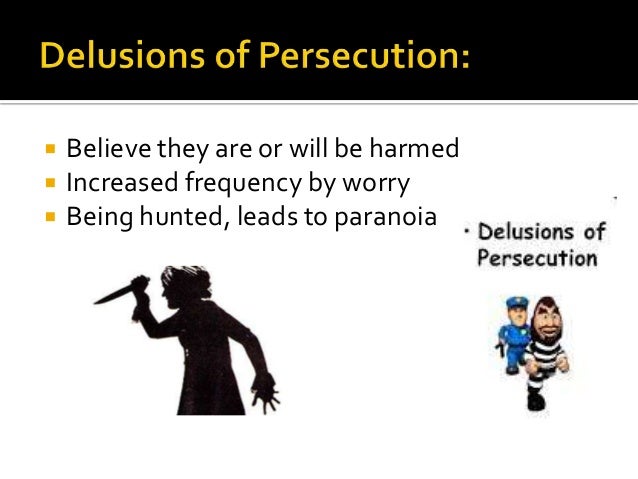

This makes conversation difficult and hard for other people to understand. Thoughts and speech may become jumbled or confused. People sometimes describe their thoughts as "misty" or "hazy" when this is happening. They may have trouble reading newspaper articles or watching a TV programme. Some people find it hard to concentrate and will drift from one idea to another. People experiencing psychosis often have trouble keeping track of their thoughts and conversations. Or you may believe there are hidden messages in everyday events or coincidences. You may believe people on TV or in newspaper articles are communicating messages to you. You may believe you're being chased, followed, watched, plotted against or poisoned. This is when you believe you're being persecuted or harassed. For example, if you hear a voice describing your actions, you may think someone is monitoring you. You may develop a delusional idea to explain a hallucination you're having. Delusions can begin suddenly, or may develop over weeks or months. It may affect the way the person behaves. Even though it's based on a mistaken, strange or unrealistic view. DelusionsĪ delusion is a belief held with very strong conviction. Voices may come from different places or one place in particular, such as the television.

discuss the hearer's thoughts and behaviour.More often they're rude, critical, abusive or annoying. Some people describe the voices they hear as friendly and pleasant.
/negative-symptoms-in-schizophrenia-2953123_FINAL-ef951f16569040e480dd672d00697f7f.png)
These show the experience of hearing voices as a real one - as if the brain mistakes thoughts for real voices. Even though people around them can't hear the voices or experience the sensations.īrain-scanning shows changes in the speech area, in the brains of people with schizophrenia, when they hear voices. Hallucinations are very real to the person experiencing them. The most common hallucination is hearing voices. Hallucinations are when you see, hear, smell, taste or feel things that don't exist. For example, appearing emotionless and flat, with confused or muddled thoughts. Negative symptomsĪ withdrawal or lack of function that you would not usually expect to see in a healthy person. Positive symptomsĪny change in behaviour or thoughts, such as hallucinations or delusions. The symptoms of schizophrenia are usually grouped into the following types of symptoms. Even when there are no obvious external symptoms. Thoughts can still be confused or muddled. They can then go through periods with few or no symptoms. People often have episodes of schizophrenia when their symptoms are severe. For example, becoming socially withdrawn and unresponsive. With young people, some symptoms can be mistaken for normal adolescent behaviour. The first signs can be hard to identify as they often develop during the teenage years. Schizophrenia changes how a person thinks and behaves.


 0 kommentar(er)
0 kommentar(er)
